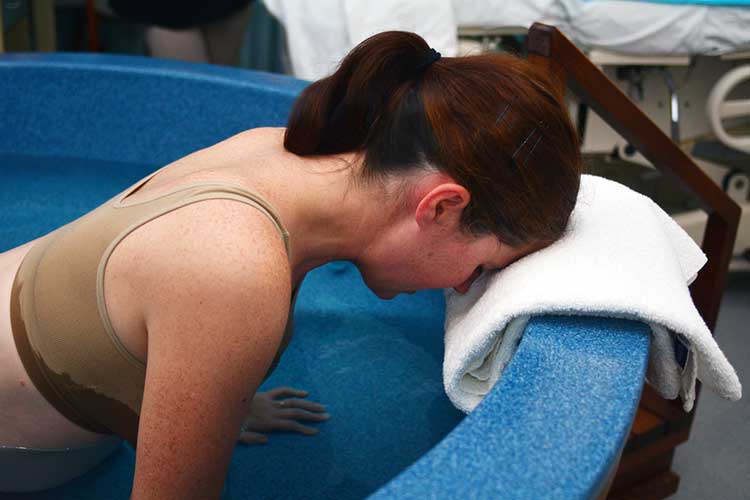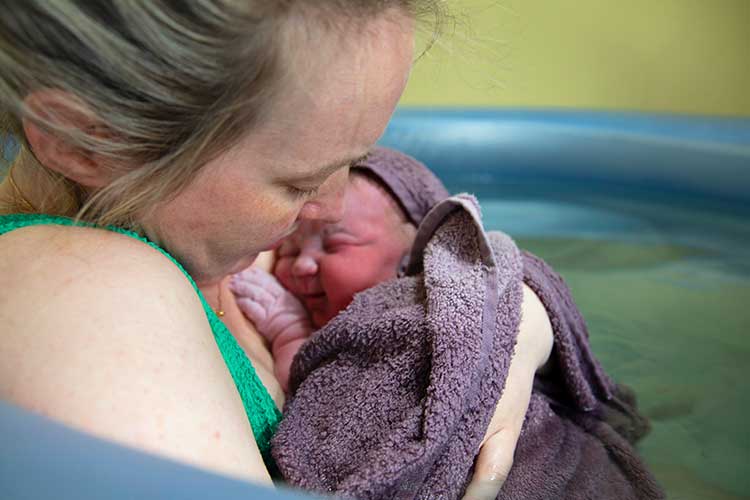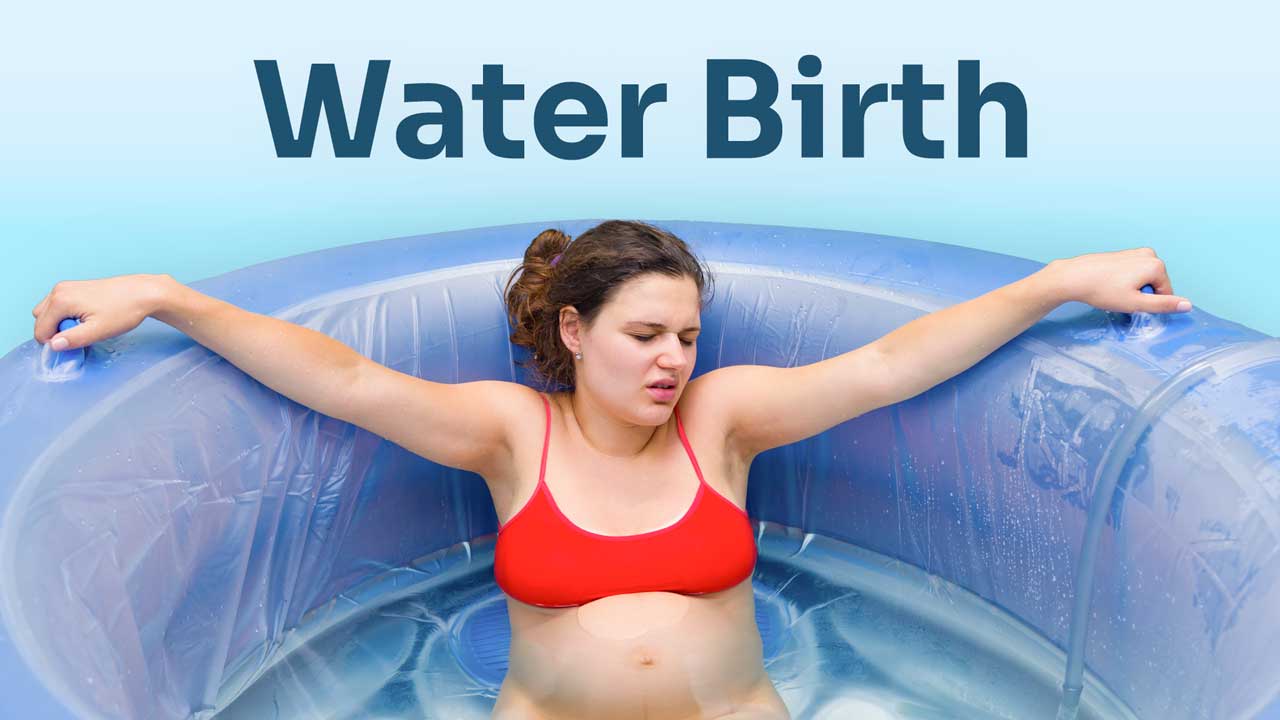Water births and water immersion in labour first became popular back in the 1970s when it was noticed that people relaxing in water gave birth more easily.
Initial fears about the baby drowning were unfounded, and water birth has been growing in popularity ever since.
Despite a huge rise in consumer demand for water birth in recent years, it’s not suitable for everyone and the following pre-requisites are generally accepted as standard:
- An uncomplicated singleton pregnancy
- A cephalic (head-first) presentation
- At least 37 weeks gestation.
(Pregnancy, Birth & Baby 2024)
Benefits, Risks and Contraindications for Water Birth
When evaluating the research, it’s important to make a clear distinction between water immersion and water birth:
- Water immersion is when the labouring person’s abdomen is completely submerged during any stage of labour, but gets out before the baby is born
- Water birth is when the labouring person remains in the water until the birth is complete and the baby is safely brought to the surface.
(ACM 2023; Dekker 2024)

Warm water immersion is now generally accepted as a safe and effective way of relieving the intensity of pain associated with labour, elevating the release of endorphins, increasing the labouring person’s feelings of control and facilitating relaxation (ACM 2023).
Potential Benefits of Water Immersion and Water Birth for the Labouring Person
- Less pain
- Reduced need for pain relief
- Shorter labour
- Higher satisfaction with the birth experience
- Reduced risk of episiotomy
- Reduced risk of postpartum haemorrhage
- Reduced augmentation rates.
(ACM 2023)
At this stage, water immersion and water birth do not appear to affect:
- Mode of birth
- Risk of serious perineal tear.
(Gold Coast University Hospital 2023)
Risks of Water Immersion and Water Birth
Despite the common concern that neonates may experience respiratory difficulties or drown upon being born in water, current research suggests that water immersion and water birth pose no increased risk to the birthing parent or baby compared to giving birth on land (RANZCOG 2021).
However, due to the small size of these studies, further research is still required (RANZCOG 2021).
Contraindications for Water Birth
Water birth isn’t suitable for all mothers. There are several contraindications that must be excluded before immersion and birthing in water can be considered a safe option.
Previous obstetric history:
- Postpartum haemorrhage
- Shoulder dystocia.
Medical history:
- Positive for HIV, hepatitis B or hepatitis C
- Epilepsy.
Current pregnancy:
- Pre-eclampsia
- Intrauterine growth restriction or macrosomia
- Current risk factors for shoulder dystocia
- BMI > 35 (this may make it difficult to remove the patient from the water during an emergency)
- Twins.
During labour:
- Induction of labour
- Pre-term birth
- Malpresentation
- Meconium stained liquor
- Fever or evidence of infection
- Fetal heart rate abnormalities
- Maternal opioid use within the previous 4 hours
- Epidural analgesia.
(SCV 2021; Gold Coast University Hospital 2023; Pregnancy, Birth & Baby 2024)
The following are typically not contraindications for water birth:
- Pre-labour or prolonged rupture of the membranes
- Previous caesarean birth or uterine surgery, unless there are signs of impending uterine rupture
- Group B Streptococcus.
(Gold Coast University Hospital 2023)
Assessing the Evidence

Internationally and in Australia, water immersion and water birth are endorsed as options for pain relief and improving the birthing experience. It’s recommended that healthcare services give labouring patients the option for water immersion and/or water birth and allow them to make informed decisions (SCV 2021).
In low-risk pregnancies, there is no evidence to suggest that water immersion or birth pose a risk of harm to the labouring person or neonate, as long as healthcare staff are properly trained and follow evidence-based guidelines (SCV 2021).
Furthermore, there is no conclusive evidence suggesting that water birth increases the risk of water aspiration, infection, mortality, morbidity or other poor neonatal outcomes (SCV 2021).
As consumer demand for water birth continues to rise, Dekker (2024) suggests that if a pregnant person has a strong desire for a water birth, and there are appropriately experienced staff present, then there is no evidence to deny them this option.
Test Your Knowledge
Question 1 of 3
Which one of the following is typically NOT a contraindication for water birth?
Topics
References
- Australian College of Midwives 2023, Position Statement: Use of Water Immersion for Labour and/or Birth, ACM, viewed 4 July 2025, https://midwives.org.au/Web/Web/About-ACM/Guiding-Documents.aspx
- Dekker, R 2024, ‘The Evidence on: Waterbirth’, Evidence Based Birth, 14 February, viewed 4 July 2025, https://evidencebasedbirth.com/waterbirth/
- Gold Coast University Hospital 2023, Warm Water Immersion During Labour, Queensland Government, viewed 4 July 2025, https://www.goldcoast.health.qld.gov.au/sites/default/files/PUB.0309.02_Water%20Immersion%20in%20Labour_Patient%20Information%20Brochure%20%28A4%29_0.pdf
- Pregnancy, Birth & Baby 2024, Water Birth, Australian Government, viewed 4 July 2025, https://www.pregnancybirthbaby.org.au/water-birth
- Royal Australian and New Zealand College of Obstetricians and Gynaecologists 2021, Water Immersion During Labour and Birth, RANZCOG, viewed 4 July 2025, https://ranzcog.edu.au/wp-content/uploads/Water-Immersion-Labour-Birth.pdf
- Safer Care Victoria 2021, The Use of Water During Labour and Birth, Victoria State Government, viewed 7 July 2025, https://www.safercare.vic.gov.au/sites/default/files/2021-05/GUIDANCE_Water%20for%20labour%20and%20birth.pdf
 New
New 
